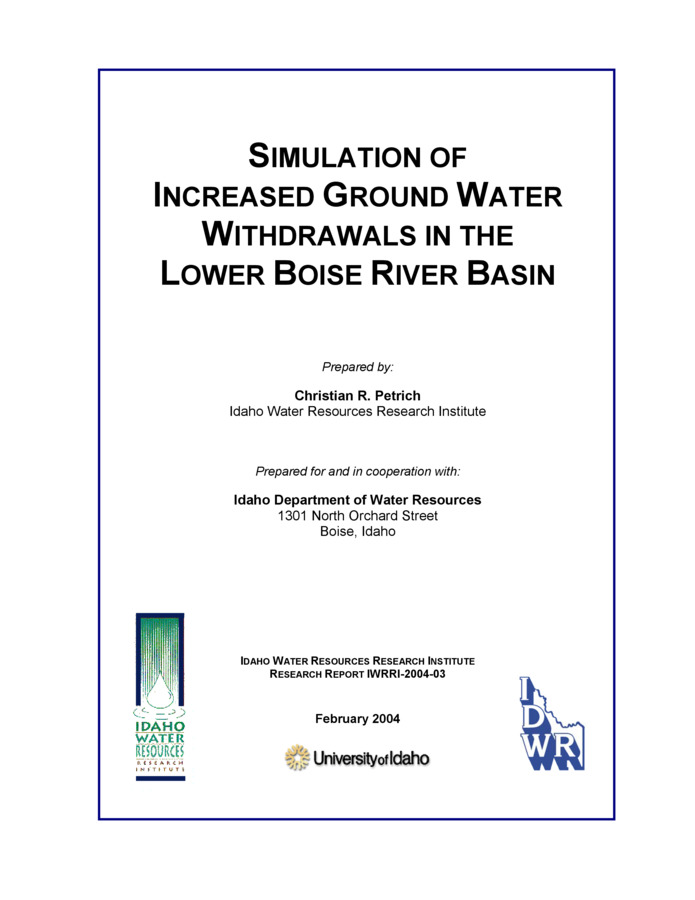PDF
Simulation of increased groundwater withdrawals in the lower Boise River basin Item Info
- Title:
- Simulation of increased groundwater withdrawals in the lower Boise River basin
- Authors:
- Petrich, Christian R.
- Date Created (ISO Standard):
- 2004-02
- Description:
- Currently there are over 450 unprocessed applications for new water rights in the lower Boise River basin, an area of southwestern Idaho that is home to approximately 35% of Idaho's population. The additional water is being requested for irrigation, municipal, commercial, and aesthetic uses. The water requested for non-supplemental purposes could represent approximately a 20% increase over 1996 levels of groundwater withdrawals. The potential impact of processing these new well applications on regional groundwater levels was evaluated using the Treasure Valley groundwater flow model (Petrich, 2004a). The Treasure Valley groundwater flow model was constructed with the USGS MODFLOW code (McDonald and Harbaugh, 1996) and calibrated to steady-state hydraulic conditions using the PEST parameter estimation code (Doherty, 2000). The calibration was based on over 200 water level and 6 vertical head difference observations. Predictive analysis (Doherty, 2000) was used to estimate worst (and best) potential outcomes given parameter non-uniqueness in the calibrated model. The simulation results indicated that aquifer level declines might occur if all of these currently unprocessed, non-supplemental, groundwater rights were granted. Water level declines could be in the range of 10 feet to over 40 feet, depending on valley location, actual amount of withdrawals, and depth of extraction. Local areas of simulated declines were noted south of Lake Lowell in an area in the northwestern portion of the model and in portions of an area between Boise, Meridian, and Kuna. These may be associated with unrealistically high simulated stresses or excessively low simulated aquifer parameter values. The simulated declines also may indicate potential problems in supplying the increasing groundwater demands in these areas. The least declines were predicted in the uppermost model layer, which corresponds roughly with the uppermost 200 feet of aquifer. Most of the estimated new simulated withdrawals in the uppermost layer resulted in decreased discharge to drains. The simulated declines presented in this report are the result of both calibration effects and increased withdrawals. Additional comparisons between minimum base calibration heads and prediction heads should be conducted to refine these predicted declines.
- Subjects:
- groundwater flow Boise River watershed computer simulation Ada County Canyon County
- Location:
- Boise River
- Latitude:
- 43.65
- Longitude:
- -116.44
- Collection:
- Boise Basin
- Series:
- Research Report
- IWRRI number:
- 200403
- Rights:
- In copyright, educational use permitted. Educational use includes non-commercial reproduction of text and images in materials for teaching and research purposes. For other contexts beyond fair use, including digital reproduction, please contact the University of Idaho Library Special Collections and Archives Department at libspec@uidaho.edu. The University of Idaho Library is not liable for any violations of the law by users.
- Publisher:
- Idaho Water Resources Research Institute; University of Idaho
- Contributing Institution:
- University of Idaho
- Type:
- Text
- Format:
- application/pdf
- Cataloger:
- Jodi Haire
- Date Digitized:
- 2004-03-09
Source
- Preferred Citation:
- "Simulation of increased groundwater withdrawals in the lower Boise River basin", Idaho Waters Digital Library, University of Idaho Library Digital Collections, https://www.lib.uidaho.edu/digital/iwdl/items/iwdl-200403.html
Rights
- Rights:
- In copyright, educational use permitted. Educational use includes non-commercial reproduction of text and images in materials for teaching and research purposes. For other contexts beyond fair use, including digital reproduction, please contact the University of Idaho Library Special Collections and Archives Department at libspec@uidaho.edu. The University of Idaho Library is not liable for any violations of the law by users.
- Standardized Rights:
- http://rightsstatements.org/vocab/InC-EDU/1.0/

